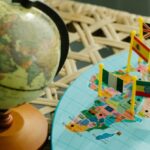In a rapidly evolving world where technology and globalization are shaping the way we interact with our surroundings, the concept of spatial literacy has never been more relevant. Spatial literacy refers to the ability to understand and interpret the spatial dimensions of our environment, including maps, diagrams, and other representations of space. This skill is crucial in today’s world for a variety of reasons, from navigating physical spaces to making informed decisions based on spatial information. Let’s delve deeper into what spatial literacy entails and why it is essential in the contemporary landscape.
The Importance of Spatial Literacy in a Digital Age
In an age where technology has made the world more interconnected than ever before, spatial literacy plays a vital role in helping individuals navigate the complexities of the digital landscape. From using GPS systems to find our way in unfamiliar places to interpreting data visualizations and maps on our devices, spatial literacy allows us to make sense of the spatial information that surrounds us. As we rely more on digital tools and platforms for information and communication, the ability to understand and interpret spatial data becomes increasingly valuable.
Enhancing Problem-Solving Skills
Spatial literacy is not just about understanding maps and charts; it also involves developing problem-solving skills that can be applied in various contexts. By honing their spatial literacy, individuals can enhance their ability to analyze spatial relationships, identify patterns, and make connections between different pieces of information. This skill is particularly valuable in fields such as architecture, engineering, urban planning, and geography, where spatial thinking is essential for solving complex problems and designing effective solutions.
Empowering Decision Making
In a world where data drives decision-making processes, spatial literacy empowers individuals to make informed choices based on spatial information. Whether it’s analyzing demographic trends, planning transportation routes, or assessing environmental impact, spatial literacy enables individuals to visualize and understand the spatial implications of their decisions. By incorporating spatial thinking into decision-making processes, individuals can better anticipate outcomes, mitigate risks, and optimize resources for more effective results.
Fostering Creativity and Innovation
Spatial literacy is not just a practical skill; it also fosters creativity and innovation by encouraging individuals to think spatially and imagine new possibilities. By understanding how space influences our interactions with the world around us, individuals can explore innovative solutions to complex problems and envision new ways of organizing and utilizing spatial resources. From designing sustainable cities to creating interactive maps and visualizations, spatial literacy fuels creativity and drives innovation in a wide range of fields.
Navigating a Complex and Interconnected World
In today’s globalized world, spatial literacy is essential for navigating the complexities of our interconnected environment. Whether it’s understanding the spatial dynamics of urbanization, analyzing the impact of climate change on landscapes, or mapping out supply chains across continents, spatial literacy provides individuals with the tools they need to comprehend and engage with the spatial dimensions of our world. By developing their spatial literacy skills, individuals can better navigate the challenges and opportunities presented by our increasingly complex and interconnected global landscape.
In conclusion, spatial literacy is a critical skill in today’s world, enabling individuals to understand, interpret, and navigate the spatial dimensions of our environment. From enhancing problem-solving skills and empowering decision-making processes to fostering creativity and innovation, spatial literacy plays a crucial role in shaping how we interact with the world around us. By cultivating spatial literacy skills, individuals can better navigate the complexities of our interconnected world and contribute to creating more sustainable and inclusive environments for future generations.





